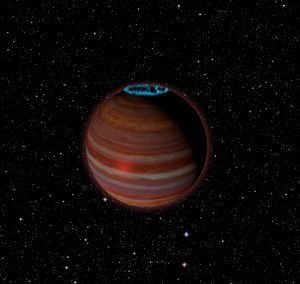Using VLA and Spitzer observations, astronomers are able to determine wind speeds on a brown dwarf for the first time. They believe the technique also could be used for exoplanets.
Select :
aasactive galactic nucleusALMAanniversaryARDCasteroidasteroidsAtacamaAtacama Large Millimeter/submillmeter arrayAUIaui programAUI Scholarshipawardsbaselinebinarybinary starsblack holeblack holesblazarBroader Impactsbrown dwarfCaltechcasaCDLcensusCentral Development LaboratoryCepheus acfachandracoma berenicesComa clustercometscosmic explosioncosmologycryoCSOdark matterdead galaxyDecadal Surveydeep fielddeep field imagingdftaudigital backenddistant galaxydiversityearly universeEHTEMSequityeventexoplanetexoplanetsfast radio burstFast Radio Burstsfirst fringesflarefotaufrbfringesfundinggalaxiesgalaxies mergergalaxygalaxy clustergalexgamma ray burstgbogbtgravitational lensgravitational wavesgreen bank observatorygreen bank telescopeH20HAM Radiohelical magnetic fieldhonorsHubbleHugheshvachw2hydrogenimage contestinclusioninternational women's dayIoJansky FellowshipsJansky Lecturejetjet collimationjetsJupiterLeroyLGBTlocal oscillatorlow noise amplifierm83M87magnetarMagnetarsmagnetic fieldsmaserMilky Waymolecular cloudsmoumtexNACnasaNational Astronomy ConsortiumNational Science Foundationnear earth objectsNEOsneutron starsneutron-star mergernglcngVLANINENMnraoNRQZNSFNSF NRAOODIopen houseOrionparkes radio observatorypawseypeoplePHANGSplanetary defensePlanetary Radarplanetary scienceplasmaPostdoctoral researchPRIDEprotoplanetary diskprotoplanetsprotostarprotostarsprotostellar jetPROVOCAproxima centauripulsarqorvoquasarradarradio telescoperam pressure strippingraytheonreceiverreceiver upgradeREUrixindustriesSchinnererscholarshipscience casesSETIsgrASMBHsofiasoftwareSolar Systemspectrumspiral galaxiesstar deathstar factorystar formationstarbirthstarsstellar flarestellar nurseriesSTEMsummer researchsupernovasupernova remnanttidal disruption eventstradestradesmenunmupgradeusnovery large arrayvery long baseline arrayviaVLAvla open housevlassVLBAvlbivndawaterxkaxray


VLA Detects Possible Extrasolar Planetary-Mass Magnetic Powerhouse
Astronomers have used the VLA to detect a possible planetary-mass object with a surprisingly powerful magnetic field some 20 light-years from Earth. It can help scientists better understand magnetic processes on stars and planets.





